Freshman students tackle CubeSat models
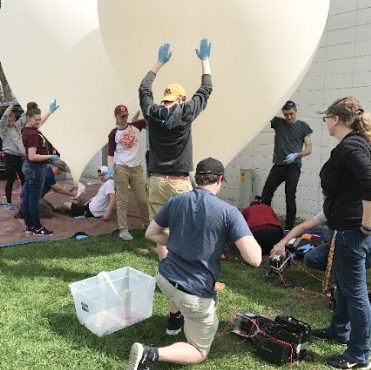
Students in the AEM all-freshman course, “Introduction to CubeSats,” spent their spring semester designing, building, and flying devices that look and operate like functional picosatellites called CubeSats. A CubeSat is a type of miniaturized satellite used for space research. Because of their small size (10cm x 10cm x 10cm), they have a much lower cost than traditional satellites, making them ideal for riskier experiments.
The course was taught by Professor James Flaten, and consisted of 10 students, who were divided into three teams. All teams went through the same general process of designing their CubeSat with the use of Computer-aided design (CAD), and used 3D printers, laser cutters, and water jet cutters for fabrication. However, each team designed their satellite with a different function in mind.
Team Modulus
Team members: Lukas Zumwalt and Ryan Thomas
Design goals:
- Fit a Geiger counter (used to read radiation levels) and as many other sensors as possible into a 1U (10 x 10 x 10cm) CubeSat
- Use Geiger counter and sensors (temperature, pressure, light intensity, etc.) to track radiation levels and natural weather patterns
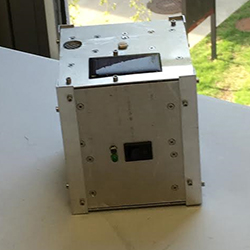
Team CSI (Camera Satellite Initiative)
Team members: Billy Herdman, Rayna Kaeppe, Alayna Erickson, and Amalia Schwartzwald
Design goals:
- Fit the University’s stratospheric ballooning team’s still imaging system into a 2U (20 x 10 x 10cm) CubeSat
- Relay pictures taken with camera to the ground via radio during the flight
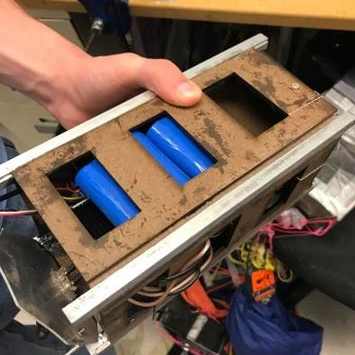
Team SPARTA (Solar Panel and Radio Testing Artifice)
Team members: Jordan Bartlett, Tanner Sticht, Emma Krieg, and Mike Rogge
Design goals:
- Test the viability of the FreeWave MM2-T (radio system) for future ballooning missions
- Design and deploy solar panels during flight
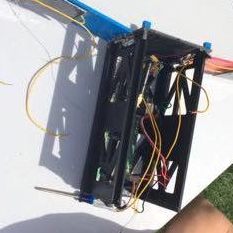
The teams began the design process by using the computer aided design application, Solidworks. For most groups this process took about 2-3 weeks, during which they quickly learned the importance of time management. “In our limited time frame we crammed weeks’ worth of early morning hours into the project,” says Modulus team member, Lukas Zumwalt.
Professor Flaten says that proper planning and time management is one of the biggest challenges students face when they take this course. “They are trying to manage a project that they don’t fully understand, they benefit from the experience, and learn what needs to be done in the future,” he say.
After designing their CubeSats using CAD, the students began the construction of their CubeSats. Each team fabricated their CubeSats using different materials, depending on their overall goals for their design; “Our CubeSat was made of wood sides with an aluminum ground plane and four metal railings to allow for the CubeSat to slide in and out of the P-POD as easily as possible,” says Billy Herdman.
Similar to the design process, many students found that the construction of their CubeSat also took longer than expected. “After the CAD was finalized, the team set about the task of printing the body, wiring the electronics, and writing the code, all of which took longer than we anticipated,” says SPARTA team member Jordan Bartlett.
In order to succeed in the project, the students were forced to learn many new and advanced skills as quickly as possible. Professor Flaten says, “The greatest benefit students receive from taking this course is that they quickly gain advanced skills that they otherwise wouldn’t have encountered this early in their academic program. They are much more prepared for future courses because of this."
Once the construction process was finished, it was time to prepare for flight. The students placed their devices into mock P-PODs (used to carry CubeSats), which were then hung from weather balloons and carried into the stratosphere to be launched.
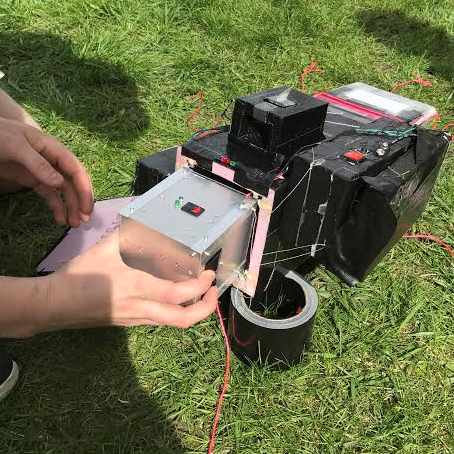
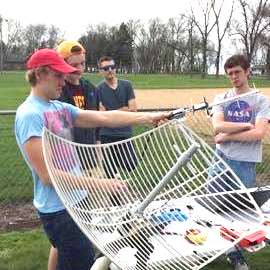
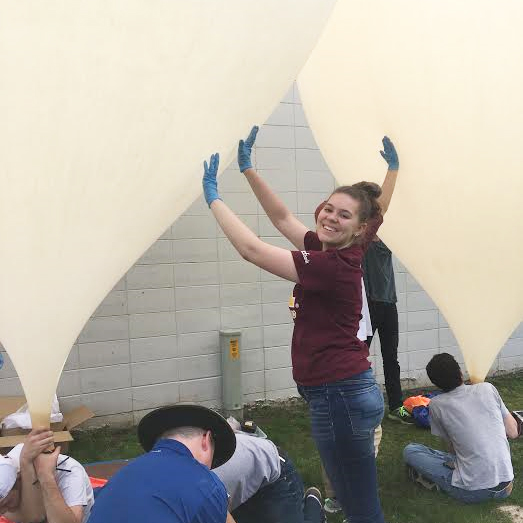
Preparing for Launch
Each CubeSat was equipped with a radio system that functioned so that the students could give the CubeSats commands, and so that the CubeSat could respond. For team CSI, this meant transporting the images taken by their CubeSat to the ground for retrieval. “Our mission plan was to take still images every minute after deployment and to relay a picture of low quality and resolution to the ground via radio once or twice during the flight,” says CSI team member, Billy Herdman. High-resolution photos were also taken and saved on-board for post flight analysis.
Once the CubeSats reached a high enough altitude to be launched, they were ejected by a spring to hang below the P-POD, and the students began to operate them like real CubeSats. “After launching the balloon, we received data for about 45 minutes, but then lost contact with the radio. We believe this was probably because we didn’t have accurate enough equipment at our ground station to properly track the balloon after losing sight of it,” says Jordan Bartlett.
Team SPARTA wasn’t the only group to experience flight day issues. “We faced power issues on launch day, which was disappointing as it did not allow for our whole project to work,” says Bill Herdman. Instead of getting discouraged, the students looked at the challenges they faced as opportunities to learn. “This was a helpful issue to face for the future as it forced the group to prioritize the limited power available. We had to learn about the most beneficial steps to take to in order for the project to continue in the most effective way possible,” continues Billy.
After the flight, the students recovered their CubeSats and analyzed the data they had collected. “After the flight we prepared a miniature display with an XBEE and a Geiger counter to demonstrate our communication process. We also explained how our data had been flawed or corrupted due to limited space, excessive wiring, and power limits with our scratch-made voltage dividers,” says Lukas Zumwalt. Again, the students looked at the mistakes they made as opportunities to learn. “We found that we learned a lot more from the process than from the actual flight data, and what mistakes to avoid again in the future as well as how you deal with the inevitable issues,” continues Lukas.
For Team SPARTA, the process of analyzing their data was limited to radio transmission records. “When the balloons landed, we discovered that our CubeSat, and the CubeSat of another group, were no longer attached to the balloon. This meant that they were lost somewhere during flight, and we were unable to find them,” says Jordan Bartlett. She continues, “We believe that after the balloon popped, the post-burst chaos was so great that at 40,000 ft, our CubeSat tore off the rest of the balloon and fell to the ground alone.” Thus, the data logged on board was lost.
Professor Flaten explains that this is a general occurrence in real CubeSats – ones that actually go into space are never recovered, so only data sent down by radio actually counts. So, while it is disappointing that the students lost their CubeSat, it also gave the team valuable insight into a real industrial issue.
At the end of the semester, the students displayed their hard-work in the Balas Atrium, and presented what they learned. “I felt that the exhibit added to my experience as it allowed me to present what I has done during class, why I took the class, and why it was useful. This I feel will prepare me for conversing with the public or potential employees about the project, why it was useful, and how it will help others moving forward,” says Billy Herdman.
“In the end, the class and Professor Flaten provided us (the students) with very insightful experiences and lucky opportunities,” says Lukas Zumwalt.
Last Modified: 2017-05-24 at 09:21:24 -- this is in International Standard Date and Time Notation


